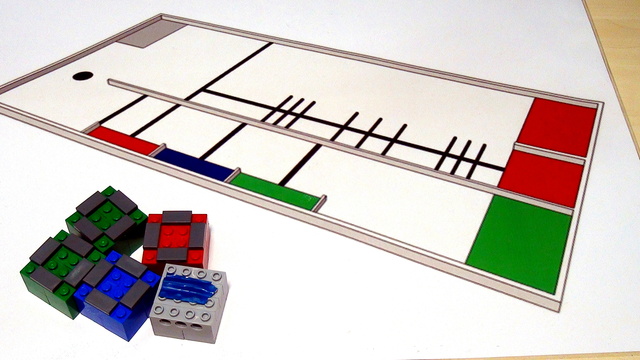

FLL 2019: How to Accomplish Mission 9 with LEGO Education SPIKE Prime
Raw footage of how the mission in completed. We might upload a more polished version soon
- #1695
- 11 Mar 2021


Raw footage of how the mission in completed. We might upload a more polished version soon


Как да сменим посоката на греда от хоризонтална във вертикална.


Как да бъдете сигурни, че изображението на дисплея ще се вижда, когато програмата приключи.


We call active attachments those that are powered with a motor. This one is in the the mission of lifting levers which is common at robotics competitions like FIRST LEGO League/World Robotics Olympiad. The attachment uses Luly, a small LEGO Education SPIKE Prime competition robot with 3D building instructions as a robot base.

We are working on the World Robotics Olympiad (WRO) 2013 competition and its elementary part. The series will introduce three different concepts and this would be Arrays, Menus and Counting different lines. In the video you will see the robot working as it is in the final stage.

Inertia triggered attachments does no require the use of a motor. Let the inertia do all the work. These kinds of attachments are very useful at robotics competitions like FIRST LEGO League and World Robot Olympiad. The robot moves, the attachment falls and grabs the ball. The attachment uses Luly, a small LEGO Education SPIKE Prime competition robot with 3D building instructions as a robot base.


This video is part of a series where we show you how our Box Robot accomplished the M10 Steel Construction mission 10 out of 10 times. The attachment is a basic lever and all the 'heavy lifting' is done by the x-y movement of the Dominator robot. This mission is one of the hard missions, because the construction is big and heavy and this requires precise movement of the robot.


Нещата, които очакваме от вас в занятие са следните:
Учениците задават въпросите;
Учениците ще сбъркат, преди да успеят;
Учениците работят в екип;
Когато Учителят говори, това е важно за всички;
Урокът се чете преди да дойдем на занятие.


Raw footage of how to accomplish the mission. A more polished version might be uploaded soon.

This tutorial demonstrates how a robot could align to a black line. The code for the program is available in the course. Aligning to black lines is popular at robotics competitions like FIRST LEGO League as it is the primary way to know where you are on the field and to develop a program that is reproducible. The attachment uses Luly, a small LEGO Education SPIKE Prime competition robot with 3D building instructions as a robot base.


We can Turn Right. We can Turn Left. How do we decide which way to go if there are lines both to the left and to the right. Check out the video.

A robot that contains balls and releases them. It counts how many balls to release depending on the "treasures" it has hunted on the field. This is part of the World Robotics Olympiad 2015 Elementary challenge.


Next state in our state machine programming pattern is the "Turn Left" state and the corresponding behaviour.
![Image for [How NOT To] Build An Active Attachment For SUV Box Robot](https://d2nmr6p48f8xwg.cloudfront.net/content_pictures/pictures/000/002/747/dd1e2e4891f89a09cc95df3c462236632bbf60d8fllcasts-competition-fll-robot-lego-mindstorms-attachment-that-is-no-good-038A5726.JPG)

The video shows why you should not build attachments such as "Crappy Active Attachment For SUV Box Robot". In the video one can see how the knob gear wheels start "jumping", once a force is applied to the lever.


Let's record the values of the Gyro Sensor while the robot is moving and is trying to keep its orientation straight. This is an interesting experiment and we will have to use file access to write the values to a file.

Moving in a grid of objects. That's the large challenge of the World Robotics Olympiad 2015 Junior-High 2015. In this video we would build a robot that can collect the boxes (treasures). The robot would also be able to move around the treasures.

Part four of the Catapult series is again about loading the catapult automatically but this time using EV3 brick, motor and sensor. We use a gear system with a medium complexity along with a "standard clutch" available in the LEGO Mindstorms EV3 kits. As a result, at the end of the video, the Catapult loads and fires automatically.

We have previously aligned to lines with the Color Sensors. In this series we are doing the same program, but with Ultrasonic Sensors that are aligning the robot to a Wall.


In this video tutorial we would look at the mission run for M09. STRENGTH EXERCISE. The mission is to lift a heavy object in the air. And that could a complex mission. It requires to use gear wheel and the attachment should be quite strong. The tutorial contains only the mission run on the field. We accomplish a single mission.


The third part of the series the goal is to extend the robot attachment so that we could solve the second part of the FIRST LEGO League World Class mission challenge - to take the loop.


Showing the same run, but from a different angle. This allows you to see more of the way we sensors work and how exactly the robot positions itself.


The attachment is now so advanced that we can do two tasks at once with it in order to solve the FIRST LEGO League 2014 World Class Search Engine Mission.

Засичането на посока с камера в Scratch е много полезен инструмент за управляване на спрайта ни чрез движение. Сега ще разберете как работи и как да го изпозлвате!


(LEGO humans of course, not real humans :) ). Working on World Robotics Olympiad 2014 elementary challenge. Collecting modules, bringing them together and lifting them. A very funny and interesting competition that we would explore in this and the next video tutorials from the series

How can you accumulate some energy in an LEGO Mindstorms EV3 construction an use this energy at a later moment? How does a Flywheel work, why is it important and what is the purpose? What is energy, inertial moment and angular velocity. These are just some of the questions we would answer in this series on Physics and LEGO Mindstorms.


This video is part of a series where we show you how our Box Robot accomplished the M07 Swing mission 10 times. This mission has a black and white line parallel right next to it, the only thing you need to figure out is how to avoid the first supporting beam of the swing. The Dominator robot waits to be clear of the beam and then uses the x-y movement of its front mottors to position the lever so it pushes the swing loose. After that the robot moves back and is ready for action again.

In this second video lesson on catapults we improve the stability of the base of the robot. An important feature of the new base is that it is not bending. Use the same principle in all of your constructions to achieve better, stronger robots.